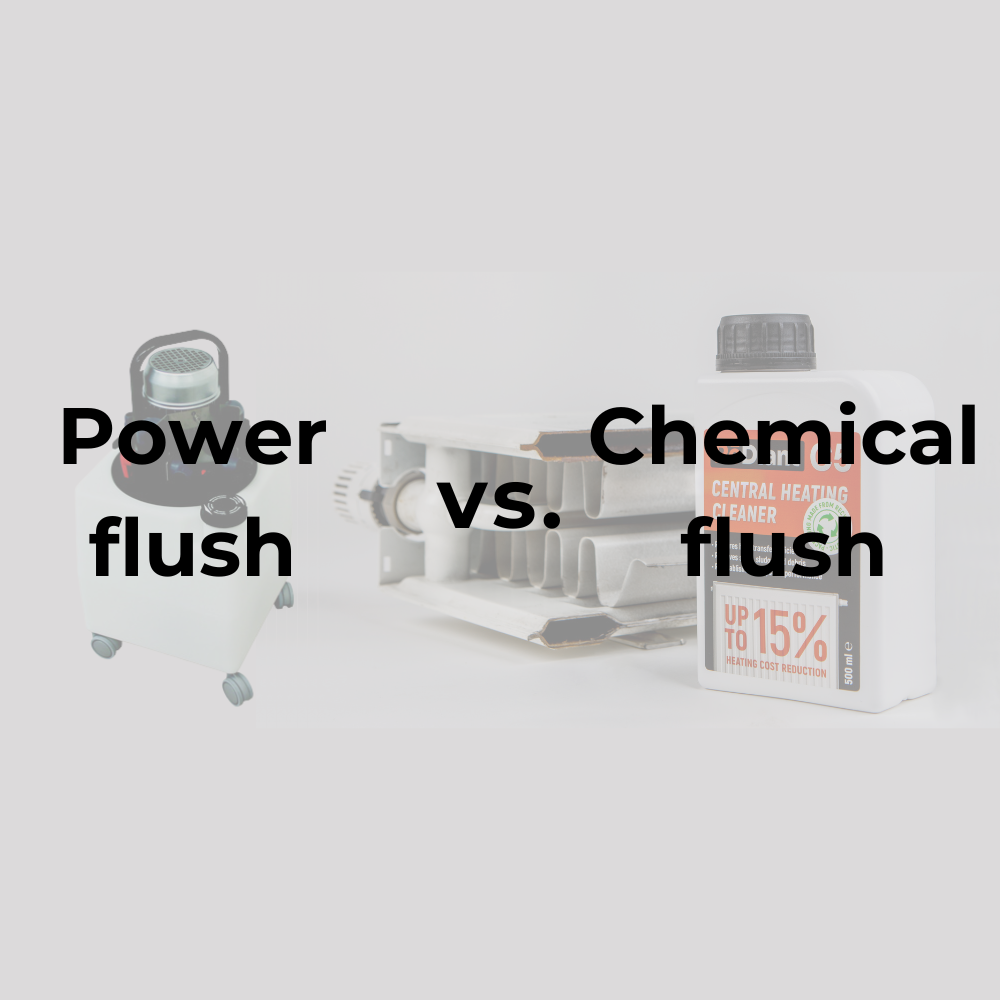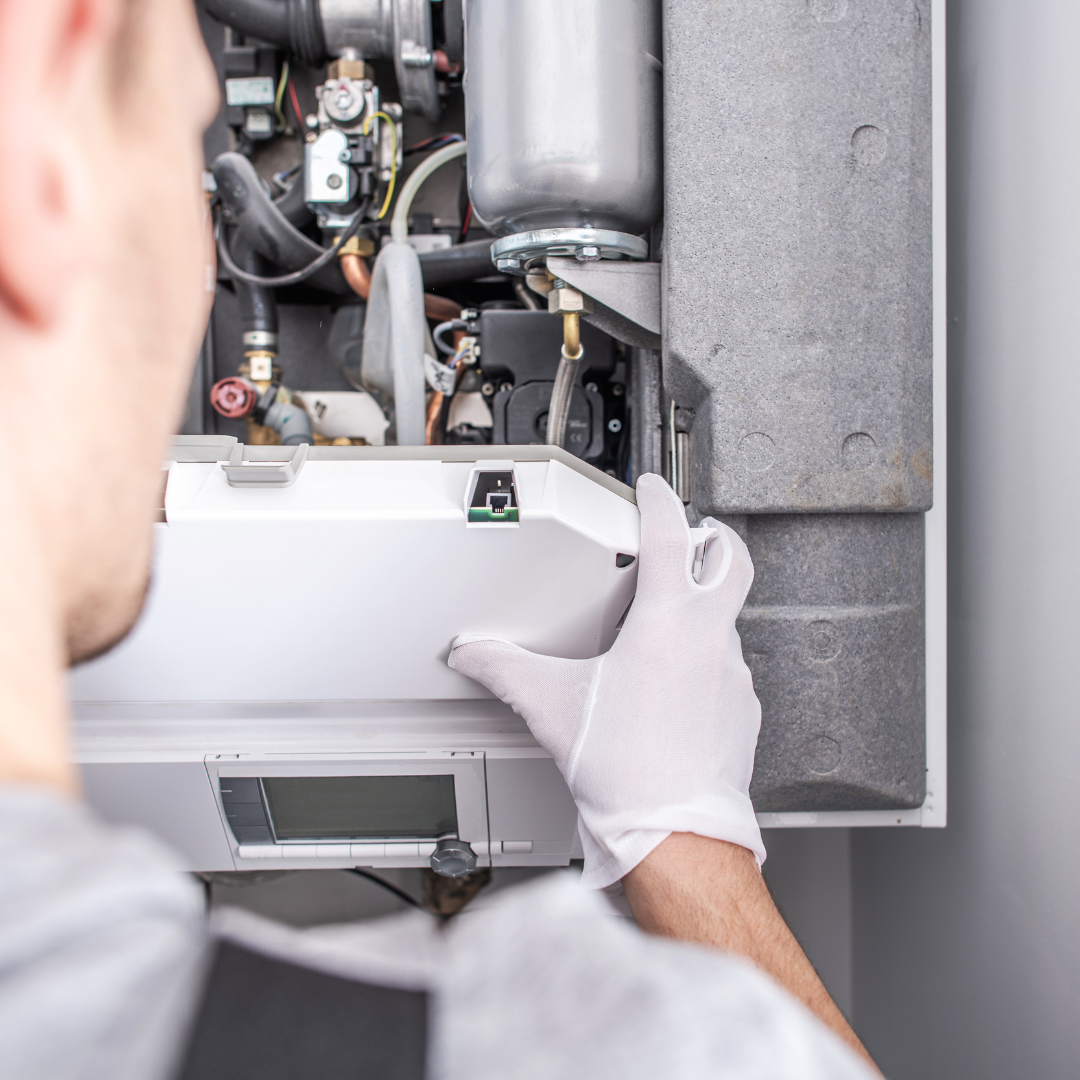As your heating system ages, the buildup of debris and sludge will lead to various system problems. Accumulated contaminants could result in clogged radiators and pipes, cold spots, slow warming, increased energy consumption by the boiler to reach the desired temperature, and reduced efficiency of the central heating system. If you’ve experienced any of these issues you can remove sludge, dirt, limescale, debris and improve longevity of your system with a flush.
Besides boosting efficiency and increasing lifespan, flushing will also prevent future breakdowns. You can choose to perform a power flush or chemical flush. Unsure about which method your system needs or don’t have an idea what they are? This article discusses both methods, what they are, the difference between them and signs that your system needs flushing.
What is a power flush?
Power flush is an efficient method, guaranteeing comprehensive system cleansing. This type of flushing involves using a power flushing machine and cleaner, such as “ReDiant C5”. Power flushing machine circulates water mixed with the cleaner at a higher pressure throughout the system to dislodge and expel sludge, debris and other particles from it. The force of the water dislodges even the most stubborn deposits, leaving the system clean for optimal performance.
How is the power flush done?
To begin, the power flush machine is connected to the system, inlet, overflow, and dump hoses are positioned in the right places. Then, the flushing process starts, the machine circulates water mixed with the cleaning chemicals in both directions. After the whole system is flushed, the radiators are flushed separately one by one. Once the system is clean and filled with fresh and clean water, an inhibitor like “ReDiant H7” is added. Finally, the power flush machine is disconnected, the system is turned on, a few tests are performed, and the process is complete. For a comprehensive step-by-step guide on how to power flush your central heating system, read our article here.
Signs that your system needs power flush
Power flushing is a powerful solution against stubborn deposits of dirt, rust, and debris within your central heating system. Therefore, it’s only needed when your central heating system is heavily contaminated. If you maintain your system and follow an annual servicing plan, a power flush might be needed every five or six years. However, the time between power flushes may vary depending on your boiler's type, age, and the system you have.
Signs that indicate your system need a power flush:
- Cold spots on radiators;
- Boiler requires constant bleeding;
- Hot pipes, but cold radiators;
- Thermostatic radiator valve is stuck in the off position;
- Radiator is cold at the bottom, but warm at the top;
- The heating system warms up longer than usual;
- Dirty water leaking from system when you bleed radiators;
- Noisy boiler operation;
- Cloudy tap water (indication of a limescale buildup);
- Non-functional radiator;
- Also, it is recommended to perform a power flush when installing a new boiler to clear the system and ensure optimum performance.
Benefits of a power flush
A power flush is an investment in energy efficiency. A cleaned and unclogged system offers the following benefits:
- Increased efficiency. This is the highest benefit of a power flush. The removal of sludge, debris, limescale, and other contaminants leads to improved circulation, allowing the boiler to work more effectively and save energy.
- Cost reduction. Improved boiler efficiency translates to lower energy costs.
- Prolongated lifespan. The flush eliminates rust and scale buildup, extending the lifespan of your boiler and reducing breakdowns. The added inhibitor prevents corrosion, rusting, and blockages.
- Improved heating quality. Clean systems provide better central heating and hot water.
- Reduced chance of breakdowns.
How long does a power flush take?
During the power flush, the heating system is off, leaving the house without hot water or heating. Thus, house owners should keep that in mind and prepare if needed. The time it takes to complete a power flush depends on your system’s size, age, and condition. On average, the process can be completed in about 6-9 hours. However, if the issues are severe, it may take longer to complete.
What is a chemical flush?
In comparison to a power flush, a chemical flush is a gentler yet effective method of clearing rust and blockages from your central heating system. Unlike high-pressure method of power flushing, chemical flushing employs natural water flow and gravity to circulate water mixed with good quality cleaner through the system. This method is ideal when the system has a small contamination and additional pressure to circulate water is unnecessary.
How is a chemical flush done?
A chemical flush involves several key steps to remove accumulated deposits and contaminants from the central heating system. First, the old water is drained from the system. Then the system is filled with new water and cleaner, such as “ReDant C5”. It’s left to circulate, allowing the cleaner to lift deposits. Afterwards, the system is flushed to remove debris and sludge. If necessary, the water is flushed through the system multiple times until it runs clear. Finally, the system is filled with clean water and an inhibitor like “ReDiant H7” is added.
Signs that your system needs chemical flush
Chemical flush is a great alternative for scenarios where power flush might be excessive. Signs of your system needing a chemical flush are pretty similar to those for power flushing but on a smaller scale. For instance, if cold spots emerge in one or two radiators or if your system takes slightly longer to heat up, performing a chemical flush will be enough to remove the minor sludge accumulation.
Benefits of a chemical flush
The benefits of a chemical flush share similarities with those of a power flush. However, their extent is limited as the process is not as thorough as power flush. Performing a chemical flush will clear the built-up debris in your central heating system, thus boosting the efficiency of your heating system. By removing rust and scale buildup, a chemical flush will also extends your boiler's lifespan and reduces unnecessary breakdowns. Additionally, a chemical flush is a more cost-effective option making it a wise choice if your system doesn't necessarily require a power flush.
How long does a chemical flush take?
As mentioned earlier, the duration depends on your central heating system's condition and the cleaner you select. A chemical flush is generally simpler to perform and involves less manual work compared to a power flush. The duration of a chemical flush can vary from a few hours to a week, yet your active involvement is typically limited to a few hours, the rest of it is chemicals and your system working to break down sludge and debris.
What type of flush is best for my heating system?
Both power flushing and chemical flushing come highly recommended as effective methods to clean your heating system and ensure optimal radiator performance. The key factor to consider is the current efficiency of your heating setup. We recommend flushing your system every few years. If most of your radiators are heating up evenly and you are not experiencing a lot of issues, a chemical flush should be sufficient. However, if you have lots of cold spots or other signs mentioned before and the system has not been cleaned in a while, a power flush might be necessary. If you hire a qualified heating engineer, they will be able to examine your system and advise on the best method.
In the ongoing pursuit of a well-functioning and energy-efficient heating system, both chemical flushing and power flushing have their place. The decision between these approaches depends on contamination level, system condition, and budget considerations. For a comprehensive system overhaul that removes even the most stubborn sludge and deposits, a power flush is incomparable. However, routine maintenance, including periodic chemical flushes, can also yield impressive results.



